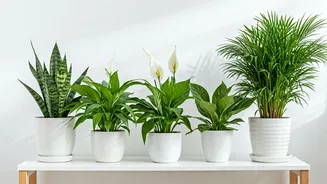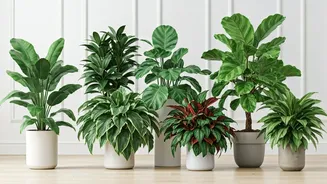The Indoor Air Problem
Indoor air quality can often be worse than outdoor air quality, posing potential health risks. Pollutants like dust, mold, and volatile organic compounds
(VOCs) from furniture and cleaning products accumulate indoors. These pollutants can lead to respiratory problems, allergies, and other health concerns. Considering the time people spend indoors, improving air quality is crucial for overall health and well-being. Using houseplants is a simple and effective way to tackle indoor pollution and create a healthier home environment.
Snake Plant (Sansevieria)
Snake plants are a top choice for indoor air purification, known for their ability to remove toxins like formaldehyde, xylene, toluene, and benzene from the air. This plant is easy to care for and can tolerate neglect, making it a great option for beginners. Snake plants release oxygen at night, making them ideal for bedrooms. They require minimal watering, typically only once or twice a month, making them a low-maintenance solution for cleaner air.
Spider Plant (Chlorophytum)
Spider plants are another effective air purifier, easily removing carbon monoxide and formaldehyde from indoor air. These plants are easy to propagate, producing “spiderettes” or baby plants that can be repotted. Spider plants thrive in bright, indirect light and well-draining soil, thriving even with occasional neglect. They are known for their ability to filter various pollutants, enhancing air quality and making them a popular choice for homes and offices.
Areca Palm (Dypsis lutescens)
Areca palms, also known as butterfly palms, are natural humidifiers and air purifiers. They effectively remove toxins such as xylene and toluene from the air. These plants also add moisture to the air, which can be beneficial in dry environments. Areca palms prefer bright, indirect light and require regular watering. Their large size makes them suitable for larger spaces, adding a touch of elegance while purifying the air.
Peace Lily (Spathiphyllum)
Peace lilies are renowned for their air-purifying capabilities, capable of removing mold spores and toxins from the air. They prefer low light conditions, making them ideal for areas with limited sunlight. Peace lilies also help to increase humidity, which can be beneficial in dry climates. They are relatively easy to care for, requiring regular watering and occasional fertilization. Their elegant appearance combined with their air-purifying properties makes them a popular choice for homes and offices, contributing to improved air quality and a more pleasant environment.
English Ivy (Hedera helix)
English ivy is effective at removing mold from the air, making it a good choice for areas prone to dampness. This plant is a climbing vine that can be grown in hanging baskets or pots. English ivy needs bright, indirect light and well-draining soil. It's important to keep English ivy away from pets, as it can be toxic if ingested. However, its effectiveness in removing airborne toxins and mold makes it a useful addition to any home to improve air quality.














